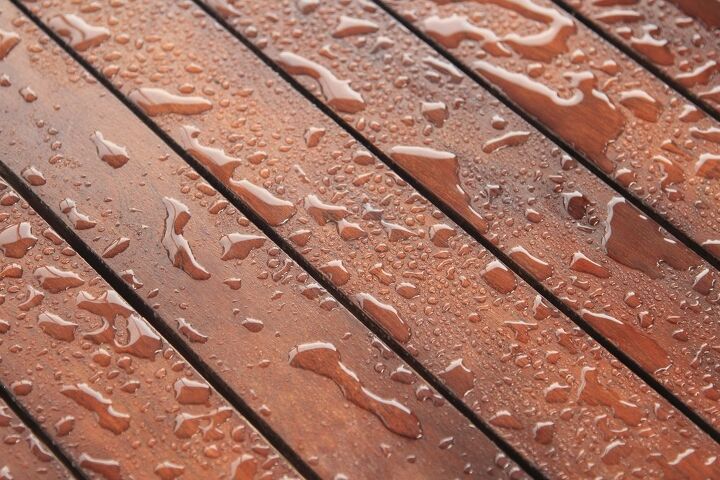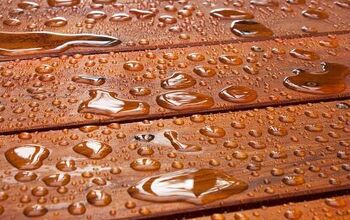Can You Use Thompson Water Seal Over Stained Wood?

Stains and sealers are very similar when it comes to protecting wooden surfaces, but there are some unique differences in terms of application, appearance, and overall protection. Many people will choose between one or the other, but some decide to use both. In this article, we’re going to figure out if you can apply specifically a Thompson water seal over wood that has already been stained.
The short answer to that is yes, you can use Thompson water seal over wood that has either a water-based or an oil-based stain as long as the stain has dried and cured completely, and the surface of the stained wood is clean and prepped. You’ll also want to keep an eye on weather conditions to ensure the sealer dries properly, too.
In some cases, it is not advised to apply a seal over a stain because many sealing products are made to penetrate the wood itself, not a layer of wood stain. This will lead to the sealer peeling and flaking instead of adhering to the surface. So, what makes Thompson water sealers different? Let’s find out.
Do You Need Deck, Fence, Patio, or Porch Cleaning and Sealing?
Get free, zero-commitment quotes from pro contractors near you.

About Thompson Water Seal
Thompson’s WaterSeal offers products that is created specifically to adhere to both oil- and water-based wood stains. These sealers are mold- and mildew-resistant as well as long-lasting and easy to apply.
Thompson’s WaterSeal® Penetrating Timber Oil is an oil-based product that will penetrate the wood pores and protect it from water infiltration. Thompson’s WaterSeal® Waterproofing Stains are water-based products with film-forming properties to repel water from the surface.
Sealing a Stained Deck with Thompson Water Seal
Adding a water seal over your stained deck can enhance its overall color, improve protection from UV rays and moisture. Before you begin sealing your deck, it’s important to make sure the surface is clean and completely cleared of any debris. After that, you simply have to prep the sealer, get your supplies, and start sealing. There are a few different ways you can apply a sealer:
- Pump-Up Sprayer: This is one of the most ideal ways to apply this water seal. Specifically, you should use a plastic sprayer with a brass wand to avoid any erosion of the seal.
- Paint Roller: You can also apply your sealer with a paint roller, though it will take a bit longer. Be sure to apply the coat in the direction of the grain to ensure even coverage.
- Paint Pad: When using a paint pad, you’ll want to pour the sealer directly onto the wood and spread it around with the pad. Keep an eye on the edges to make sure you are applying the sealer to the entirety of the surface.
Typically, it will take at least two hours for the seal to dry. However, this time will vary depending on humidity levels and the overall temperature. This is why it’s important to keep an eye on your deck after applying the seal to make sure nothing disturbs it until it’s completely dry.
You’ll usually want to reapply a sealer to your deck every one to three years. However, this will depend on what the surface is exposed to on a regular basis, such as regular sunlight, heavy foot traffic, harsh weather conditions, and more.
Thompson Water Seal Coats Needed
In most cases, you’ll only need one coat of Thompson water seal to thoroughly cover your deck. However, you can add a second coat after the first completely dries if you want to hide the grain and have a more solid look.
Important Tips for Using Thompson Water Seal on Stained Wood
Much like painting over stained wood, applying Thompson water sealers over stained wood is a fairly straightforward. That said, we do have a few pieces of advice to make the job is even easier and to ensure better results, too. Before you begin sealing your stained wood, consider the following:
- Start the project on a temperate day. Temperatures ranging from 50 to 70 degrees Fahrenheit are usually best.
- Always check the forecast. Even if the day you’re doing the actual work looks good, you’ll want to make sure there’s no rain for at least two days.
- Make sure your deck is completely dry. Before applying your sealer, make sure there is no excess water on the surface. Working with damp wood can cause longer drying times and ruin the seal job completely.
How to Know if Your Deck Needs Waterproofing
If you’re not sure if your deck needs additional waterproofing, there’s an easy way to test it out. It’s called a splash test. This involves sprinkling water on your deck and seeing if it creates a dark spot once it absorbs into the surface.
Types of Stains
Like a sealer, wood stains protect the wood from the elements. The difference lies in how they affect the wood once applied. Stains have a pigment that will protect the wood surface from harmful UV rays, rot, mold, mildew, and more.
All sealers will go on clear whereas stains can range from clear to solid. That means you can choose from many color and tint choices depending on how much you want to hide the appearance of the wood. Here’s a bit more on those options:
- Clear stains. Using a clear stain will allow you to show off the woods natural color, grain, and texture. It also allows the wood to weather naturally. While it almost looks like it’s not there, a clear stain will offer long-lasting protection for the wood’s surface.
- Transparent stains. Transparent stains will add a subtle hint of color to the wood while maintaining a lot of its natural patterns. Once applied, they almost look clear, but they do have some pigment for enhanced UV protection.
- Semi-transparent stains. Semi-transparent stains will add a beautiful pop of color to the wood while still showing off some of the natural grain. They have more pigment than transparent stains to provide the best protection from moisture.
- Solid stains. As the name suggests solid stains will hide the wood grain entirely. However, the wood’s texture will still show. They are non-penetrating, which means they sit on the surface of the wood instead of penetrating into the fibers. It is similar to paint in this way.
Related Questions
How will rain affect water sealers on stained wood?
When applying a sealer over your stained wood, you’ll want to find a time when rain is not in the forecast. You’ll want to aim for at least two full days without any rainfall to ensure the sealer is completely cured.Since the wood already has a stain, the wood itself shouldn’t experience issues. That said, the rain will affect the seal, causing it to either be splotchy or flaky.
How else can I keep my stained deck in good condition?
Staining and sealing your deck is a great way to protect it from the elements. There are some other steps you can take to avoid problems in the future. This includes keeping furniture covers spread out and moving plants away from the edges of your deck. This will stop mold and mildew growth. You also should sweep regularly and avoid using bleach on the wood fibers.
Can you polyurethane over a water seal?
You should avoid using polyurethane over a water seal. This will cause the surface to peel and flake off, which will ruin the entire surface and potentially leave it more vulnerable.
Do You Need Deck, Fence, Patio, or Porch Cleaning and Sealing?
Get free, zero-commitment quotes from pro contractors near you.

Final Thoughts on Sealing Stained Wood with Thompson Water Seal
More often than not, you are not going to need both a stain and a sealer on your wood surfaces. In fact, it is not advisable with certain sealers as they won’t properly adhere to the surface. That said, you definitely can seal stained wood with Thompson’s water sealers for an extra layer of protection against fading, rot, and water damage.

I am a copywriter and editor based in the Las Vegas area with nearly a decade of experience under my belt writing landing pages, cost guides, blog posts, newsletters, case studies, and social media content. I have a degree in Strategic Communication and experience working in both the account and creative spheres. My goal is to always be discovering new interests and bettering myself as a writer and editor along the way.
More by Kerry Souder



























